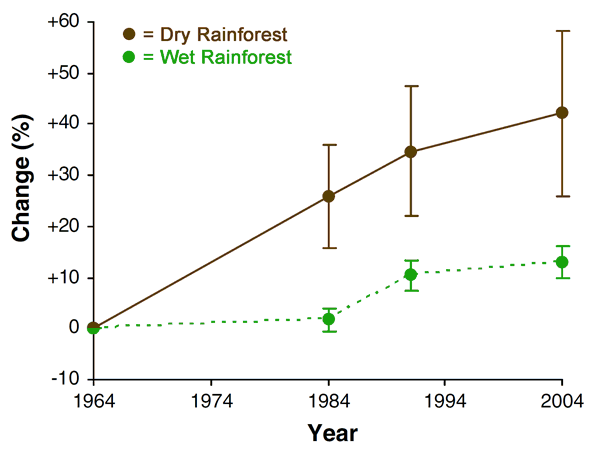The State of Earth's Terrestrial Biosphere:
How is it Responding to Rising Atmospheric CO2 and Warmer Temperatures?
Continental-Scale Analyses of Terrestrial Productivity: Australia
Moving on to Australia, we continue our review of what researchers have discovered with respect to terrestrial productivity in this part of the world.
Noting that "a number of processes are thought to be threatening the ecological integrity of monsoon rainforests in Northern Australia," Banfai and Bowman (2006) decided to test this retracting rainforest claim with a comprehensive repeat aerial photography study of the Northern Territory's Kakadu National Park, where monsoon rainforest exists as an archipelago of hundreds of small patches scattered within a larger eucalypt savanna matrix. More specifically, two Australian researchers from Charles Darwin University's School for Environmental Research set out to assess changes to the boundaries of 50 monsoon rainforest patches using temporal sequences of digitized aerial photography taken in 1964, 1984, 1991 and 2004, with the intent to understand the relative importance of factors driving any change.
Results indicated that "rainforest patches increased in size between 1964 and 2004 by an average of 28.8%" (see Figure 14), and after lengthy analyses of several phenomena that might possibly have been responsible for the range increases, the two researchers concluded that "the expansion is likely to have been primarily driven by increases in variables such as rainfall and atmospheric CO2." In this regard, for example, they note that "the average [area] change for dry rainforests from 1964 to 2004 was an increase of 42.1%, whereas for wet rainforests [the increase] was one-third of this at 13.1%." In addition, in the case of dry rainforests, they report there was "an almost linear increase in rainforest area over the study period," in harmony with the concomitant upward trends of both atmospheric CO2 and rainfall.

Figure 14. Average percentage change in rainforest area in Kakadu National Park, Northern Territory of Australia, relative to 1964 for dry rainforest (brown line) and wet rainforest (green dashed line). Standard errors are indicated. Adapted from Banfai and Bowman (2006).
In further support of the validity of their findings, and "contrary to the view that monsoon rainforests are contracting," the two researchers indicate that other repeat aerial photography studies conducted in Northern Australia have also revealed rainforest "expansion at the expense of more open vegetation." These studies include those of monsoon rainforests in Litchfield National Park near Darwin (Bowman et al., 2001) - where forest patches nearly doubled in size between 1941 and 1994 - and in the Gulf of Carpentaria (Bowman et al., 2006). In addition, they write that "these changes parallel the observed expansion of tropical rainforest on the east coast of Australia (Harrington and Sanderson, 1994; Russell-Smith et al., 2004)."
Introducing their study of the subject, Macinnis-Ng et al. (2011) say that "woody thickening" is typically defined as "the increase in woody standing biomass in a landscape already containing woody biomass." Both it and woody plant invasion, as they continue, "are global phenomena that are commonly observed in arid and semi-arid regions, including Australia (Bowman et al., 2001; Burrows et al., 2002; Asner et al., 2003; Fensham et al., 2005; Scott et al., 2006; Witt et al., 2009)," the "tropical rainforests of Central and South America (Phillips et al., 1998), and temperate forests globally (Birdsey et al., 1993)." And although they note that "the cause of woody thickening remains debated," they say "there is an increasing awareness of potential roles for climate and changes in atmospheric CO2 concentration in causing woody thickening (and woody invasion)," citing the studies of Fensham et al. (2005), Berry and Roderick (2006), Davis et al. (2007) and Sankaran et al. (2008).
Against this backdrop, the four researchers proceed to examine the responses of gross primary production (GPP) and water use of a typical Australian woodland using the soil-plant atmosphere (SPA) model of Williams et al. (1996), which they successfully applied to the functioning of a temperate open woodland in Australia (Zeppel et al., 2008) that provided a methodology for testing the conceptual model of Eamus and Palmer (2007), which posits that the increasing atmospheric CO2 concentration and the declining evaporative demand "may explain the global phenomenon of woody thickening."
Based on their analysis, Macinnis-Ng et al. were able to demonstrate that as the air's CO2 content rises, plant stomatal conductance decreases, such that water use per tree decreases and, therefore, soil water content increases, leading to increases in leaf area index that allow more light to be intercepted, enabling existing trees to grow bigger (even in the case of photosynthetic acclimation), which set of phenomena comprises the complex process of woody thickening. Noting that their results "provide a valid mechanism for the conclusion of Berry and Roderick (2002) that evergreen vegetation has increased across Australia over the past 200 years as a result of CO2 enrichment," they conclude that "woody thickening in Australia and probably globally can be explained by the changes in landscape GPP and soil moisture balance arising principally from the increased atmospheric CO2 concentration."




